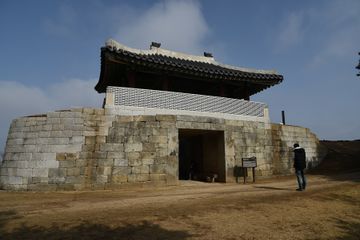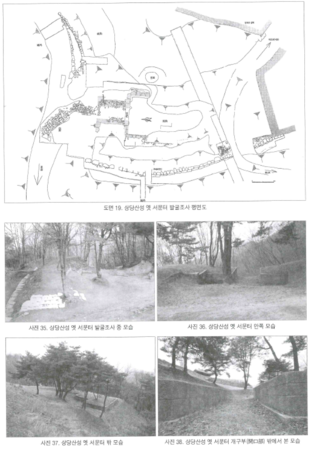서문(미호문)-청주 상당산성
| 서문(미호문) 西門(弭虎門) Western Gate (Mihomun Gate) |
|
해설문
국문
상당산성의 성문은 총 5개로 남문·동문·서문과 동북 암문(暗門)*, 서남 암문이 있다. 이 중 서문의 통행로 천장은 동문과 마찬가지로 직사각형의 돌을 수평으로 걸쳐 만들었다. 문밖 양쪽으로는 성벽을 돌출시켜 방어에 유리하도록 하였다. 이러한 구조는 암문에서 볼 수 있는데, 이를 서문에 적용하여 건축 비용을 줄이고 전술적 효과를 높인 것으로 보인다.
서문이 있는 곳의 지형은 호랑이가 뛰기 전 움츠린 모양과 닮았다. 전해지는 이야기에 따르면 호랑이가 떠나면 땅기운이 다하므로 호랑이의 목에 해당하는 곳에 성문을 세웠다고 한다. 이 때문에 서문을 ‘미호문(弭虎門)’이라고도 부른다.
문루(門樓)**는 1978년에 복원하였으나 지반 침하로 변형되어 2015년에 해체한 후 원형을 고증하여 복원하였다. 이때 문루에 사용된 수막새***의 문양과 벽돌은 1995년 서장대 발굴 조사에서 출토된 유물을 참고하여 제작한 것이다.
현재의 서문에서 북쪽으로 약 40m 떨어진 곳에서는 지금의 서문보다 앞서 만들었던 서문 터가 확인되었다. 이 서문 터는 조선 숙종 대와 영조 대에 대대적으로 수축(修築)****되기 이전의 상당산성 서문 모습을 보여주는 중요한 자료로서, 당시 발굴 조사 자료를 토대로 2003년에 정비하였다.
- 암문: 성곽을 몰래 드나들 수 있도록 만든 작은 사잇문
- 문루: 궁문, 성문 따위의 바깥문 위에 지은 다락집
- 수막새: 처마의 기왓골 끝에 사용되었던 막새기와
- 수축: 집이나 다리, 방죽 따위의 헐어진 곳을 고쳐 짓거나 보수함
영문
Western Gate (Mihomun Gate) – Sangdangsanseong Fortress, Cheongju
Sangdangsanseong Fortress has a total of five gates: three main gates (southern, eastern, and western) and two secret entrances (northeastern and southwestern). Mihomun Gate is the fortress’ western gate. The name Mihomun means “Gate of the Arching Tiger” and comes from the resemblance of the area’s terrain to a tiger about to pounce. It is said that this gate was built atop the spot corresponding to the tiger’s neck to prevent the tiger from leaving and taking the land’s auspicious energy with it.
The gate’s stone passageway has a flat, rather than arched, ceiling. The walls of the fortress curve inward toward the gate’s outer side, creating a narrow path in front of the gate that can be more easily defended than if the walls were parallel with the gate. This design, commonly used in secret entrances, were utilized in both the eastern and the western gates of this fortress, presumably to increase the fortress’s defenses while saving on construction costs.
The gate’s current wooden pavilion dates to 1978. However, the structure became warped due to settling, so in 2015 it was dismantled and then reconstructed based on historical evidence. During the reconstruction, artifacts unearthed in 1995 at the fortress’s western command post were referenced to newly create the pavilion’s convex roof-end tiles and brick enclosure wall.
The site of an earlier western gate was identified about 40 m to the north of the current gate. These remains provide valuable information about the gate’s appearance prior to the large-scale renovation of the fortress in the 17th-18th centuries. The remains were renovated in 2003 based on archaeological findings.
영문 해설 내용
상당산성에는 남문, 동문, 서문, 동북 암문, 서남 암문 등 총 5개의 문이 있었다. 미호문은 상당산성의 서문으로, 미호문이라는 이름은 서문이 있는 곳의 지형이 호랑이가 뛰기 전 움츠린 모양과 닮았다는 데서 비롯되었다. 전해지는 이야기에 따르면 호랑이가 떠나면 땅기운이 다하므로 호랑이의 목에 해당하는 곳에 성문을 세웠다고 한다.
서문의 통행로는 돌로 만들었으며, 천장은 아치형이 아닌 평평한 형태로 되어 있다. 문 바깥쪽으로 성벽을 돌출시켜 좁은 길을 만들어서, 성벽이 문과 평행으로 있는 것보다 방어에 유리하도록 하였다. 원래 이러한 구조는 암문을 만들 때 사용하지만, 상당산성에서는 동문과 서문에 이러한 구조를 적용하여 건축 비용을 줄이고 방어 효과를 높인 것으로 보인다.
지금의 문루는 1978년에 복원하였으나, 지반 침하로 변형되어 2015년에 해체한 후 원형을 고증하여 다시 복원하였다. 이때 사용된 수막새의 문양과 벽돌은 1995년 서장대에서 출토된 유물을 참고하여 제작한 것이다.
현재의 서문에서 북쪽으로 약 40m 떨어진 곳에서는 지금의 서문보다 앞서 만들어졌던 서문 터가 확인되었다. 이 서문 터는 17-18세기에 상당산성이 대대적으로 보수되기 이전의 서문 모습을 보여주는 중요한 자료이다. 이 서문 터는 발굴 조사 자료를 토대로 2003년에 정비하였다.


